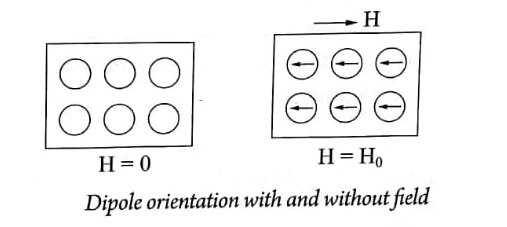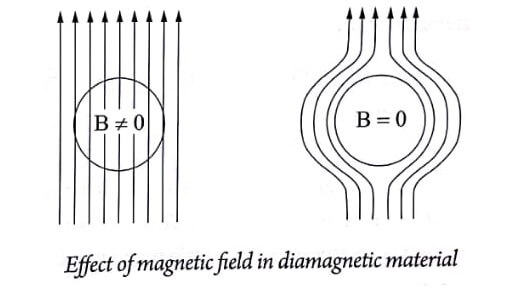Definition: “Materials which does not have permanent magnetic dipoles” are termed as Diamagnetic materials.
or
The substances which when placed in a magnetic field become weakly magnetised in a direction opposite to that of the applied magnetising field are called diamagnetic substances.
Examples: Gold, Quartz, Water, Copper, Zinc, Germanium, Silver, Lead, Silica, Helium, Bismuth etc.,
Explanation:
- The diamagnetic materials repel the magnetic lines of force when external magnetic field is applied (Fig).
- In these materials there are even number of electrons and all the electrons which spin in two opposite directions are almost equal and so they cancel out and the net magnetic moment is zero.
- They do not have any permanent magnetic moment or dipoles in the absence of external magnetic field.
- But when the magnetic field is applied these electrons reorient themselves that they align opposite to the field direction and oppose the applied magnetic field.
- Hence, the magnetic induction is almost reduced. Diamagnetism is understood by the illustration shown in Fig (a & b).

When the magnetic field H is zero, the atoms posses zero magnetic moment Fig (a). When a magnetic field is applied in the direction shown in Fig (b), the atoms acquire an induced magnetic moment in the direction opposite to that of the field.
The strength of the induced magnetic moment is proportional to the applied field and hence the magnetisation of the material varies linearly with the strength of the magnetic field. The induced dipoles and magnetization vanish as soon as the applied field is removed.

Properties
- It has no permanent dipole moments.
- It is feebly repelled by a magnet.
- Susceptibility is negative and is independent of temperature and applied magnetic field strength.
- The value of permeability is less than 1 .
- When temperature is less than critical temperature diamagnets become normal material.
- If diamagnetic substance is placed in a nonuniform magnetic field, it is attracted towards the weaker magnetic field.
| Read More Topics |
| Classification of magnetic materials |
| Origin of magnetic moments |
| Variation of carrier concentration with temperature |





